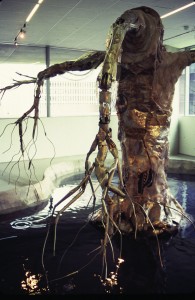Innovation is everywhere; everyone is talking about it. Innovation, now, is highly politicised, entrenched in policy statements at all levels of government and acknowledged as a key driver of economic development. To listen to the banter, this country’s future may well depend on an ability to innovate: smart this and clever that, imagine here and create there. Over the past decade there have been moves for the arts and creative thinking to feature more prominently and purposefully in innovation agendas[1].
Rosalind Krauss’ seminal essay Sculpture in the Expanded Field made it apparent that defining and delineating artforms, in this instance sculpture, is frustrated by contestation or negotiation. Krauss argued the tensions between vanguard aesthetics and historicism: “the new is made comfortable by being made familiar, since it is seen as having gradually evolved from the forms of the past. Historicism works on the new and different to diminish newness and mitigate difference.[2]” An obvious example is the ‘folding back’ of new media art practice into the Australia Council’s artform boards given that these artforms are, at some level, discursively formed. For Krauss, it is necessary to address both the problem of history and the problem of explanation in accounting for sculpture in the expanded field of postmodernism.
This suggests these matrices of ‘expanded fields’ continue to hold sway, at least at the level of public funding programs. While public funding programs and bodies do not define what is art, what is funded is constitutive of public culture. If we reject the telos that ‘new’ artforms emerge out of ‘old’ ones, as Krauss argues, then the idea of ‘emerging fields’ is potent. While some things don’t click into these matrices of expanded fields, clearly media art has history and as Lev Manovich contends, new or emerging media is grounded in ‘what came before’. But media art is also more possible and more coherent outside of the traditional artforms. Hybridity and methodology plays a necessary delineating function here. Emerging Fields, then, on the one hand imbues an ‘in-process’ quality or research methodology while on the other posits a possible site of renewal and invention.

Growing Raining Tree, Chico MacMurtrie, commissioned by the Contemporary Arts Center Unmuseum, Cincinnati, Ohio, 2003-2007. Photo: Shelly Wynecoop
As the founder and artistic director of New York based Amorphic Robot Works[3], Chico MacMurtrie works with artists, engineers and technicians to create robotic performances and installations that explore human-environment-technology interaction. Formed in 1992, this ‘collaborative’ has produced over 250 interactive and computer-controlled human and abstract machines. These machines evolved from MacMurtrie’s initial attempt to animate his puppets, and now follow an evolutionary regeneration forged from his imagination. MacMurtrie describes the works as ‘machine-sculptures’ or ‘robotic sculptures’, hyphenated entities that arouse the limits of an expanded field. Something else is at stake as the ARW experiments with MIDI computer control to actuate the behaviours of the robots and several of their works, such as a Tumbling Man and Walking Trees, concentrate on experiments with motion and various forms of control (e.g. sensors). Their performances, such as The Ancestral Path[4], can include up to 60 robots, each with unique abilities.
Presently based in the UK, Tina Gonsalves is the first artist in residence at the Institute of Cognitive Neuroscience at University College London. On a one-year international fellowship from the UK Arts and Humanities Research Council and Arts Council England, Gonsalves is working with Neuroscientist Dr Hugo Critchley to explore the psychophysiological data of the body to drive affective video displays. This project is part of Gonsalves’ ongoing inquiry into interactivity and intimacy including her most recent work, a collaboration with London-based engineer Tom Donaldson, Medulla Intimata, which is responsive video jewellery[5]. This wearable hybrid work crosses public intervention with jewellery, fashion, performance, bio-metrics, technology and moving image. The necklace contains a video screen and biometric sensors which, using analysis of speech and tone, monitor the wearer’s emotions and video is displayed on a screen embedded in the jewellery.
As projects like those of Gonsalves and MacMurtie attest, innovation requires longer term resourcing than one-off project grants particularly given the research intensive nature of emerging fields which are innovating with new technologies across a range of applications. Both are involved in inquiries and processes that have spanned close to a decade. In our accounts of the emerging fields, multiple narratives are at play but there is also a need to be mindful of the narrative’s propensity for positing beginnings and endings. If there is a need for ongoing investment in innovation as reports such as Imagine Australia emphasise (see footnote 1), there is equally a need for flexible approaches to funding and collaboration.
Research and development is integral for emerging fields in the arts and creative industries to thrive. Where the appropriate mix of funding, resourcing, sustainability, time and interdisciplinary collaboration has been seeded, highly productive and satisfying research cultures also emerge. At the Art/Science Collision forum in New York last year, MacMurtrie stressed that artists have something unique to contribute to scientific inquiry. Artists have been pushing thresholds on small budgets, but necessity isn’t a virtue and as MacMurtrie concluded “artists should receive more funding”.
Linda Carroli
Linda Carroli is a cultural writer, editor, researcher and consultant.
References
[1] See the report Imagine Australia, a paper prepared by an independent Working Group for the Prime Minister’s Science, Engineering and Innovation Council (PMSEIC) examines the role of creativity in the information economy at http://www.dest.gov.au/NR/rdonlyres/B1EF82EF-08D5-427E-B7E4-69D41C61D495/8625/finalPMSEICReport_WEBversion.pdf. Also, the Australia Council has made a submission to the PMSEIC to promote the strategic value of arts for the innovation available at http://www.australiacouncil.gov.au/about_us/submissions2
[2] Rosalind E. Krauss, ‘Sculpture in the Expanded Field’. The Originality of the Avant-Garde and Other Modernist Myths. Cambridge: MIT Press. 1985, p 277
[3] www.amorphicrobotworks.org
[4] For a technical description of this work see http://users.skynet.be/P-ART/PARADISE/JOURNAL/JOURNL43/journ43.htm
[5] www.tinagonsalves.com/medulla.html
 This work is licensed under a Creative Commons Attribution-NonCommercial-ShareAlike 3.0 Australia.
This work is licensed under a Creative Commons Attribution-NonCommercial-ShareAlike 3.0 Australia.






